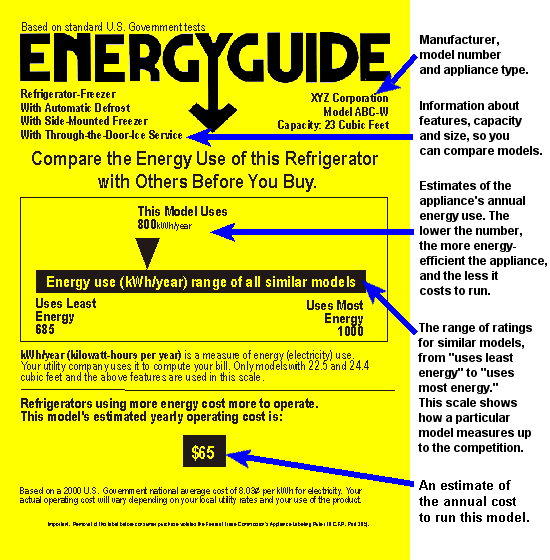|
|
About Refrigeration In the United States and elsewhere in the world, refrigerators are a nearly universal kitchen appliance. Refrigerators perform the fundamental tasks of preserving food, keeping beverages chilled, and making ice. Of all household appliances, the refrigerator consumes the most energy. Unlike the intermittent use of other applicances, it must fight a 24/7 battle to keep the kitchen's heat from invading its interior. Specifically: - Heat is constantly conducting through its walls - Its doors are opened many times throughout each day, exposing its interior to the warmer kitchen air - Its fan motor and compressor generate heat underneath the unit [Diagram of the heat flows] The refrigerator itself is basically a steel box with doors on one side and a refrigeration system in its base. To minimize the conduction of heat through its walls, insulation is packed in between its inner and outer shells. Until recently, polyurethane foam was most common insulating material. Environmental concerns have forced the replacement of foam with xxxxx, which, though more expensive, has superior insulating performance. Cooling the air inside the refrigerator is accomplished through a series of coils that run through the back wall of the unit. A refrigerant fluid runs through these coils. Until recently, the most commonly used fluid was Freon. As with the foam insulation, manufacturers have stopped using Freon for environmental reasons. Its replacement, CRC XX, does not have any adverse effect on the environment. As the refrigerant itself passes through evaporator coils inside the refrigerator's walls, it draws heat away from the inside air, causing the air temperature to drop. As the heat conducts through the walls and coils, the temperature of the refrigerant increases, causing the refrigerant to transform from a liquid to a vapor. This vapor routes through the compressor where its temperature and pressure increase. Next, the vapor passes through the condensing coils mounted on the outside of the refrigerator. As a fan blows room air over the coils, the temperature of the vaporized refrigerant falls, causing it to condense back to a liquid. During the transformation, the latent heat of the refrigerant is transferred through the coils to the room air. As the condensed refrigerant is passed through an expansion valve on its way back to the evaporator coils, its pressure drops, and the cycle begins again. [Diagram of cycle] Although a refrigerator is "on" all the time, almost all of its energy consumption takes place when its compressor is turning. A thermostat inside the refrigerator activates the compressor whenever the inside temperature drops below the set point. Over the last twenty years, energy consumption of comparably sized refrigerators has dropped an average of 75%. This is not a misprint. Higher efficiency compressors, improved insulation, and better door seals have been responsible for most of this improvement. In 2006, the U.S. Department of Energy (DOE) will raise energy standards by another 20%. With the magnitude of these efficiency gains, almost every refrigerator more than 15 years old can be justified for immediate replacement based on energy savings alone. The table below illustrates the payback potential. Under present standards, any refrigerator using at least 10% less electricity per year than the DOE standard is designated as an Energy Star appliance. When shopping for a new refrigerator, look for the Energy Star label and the Energy Guide label. The latter will explicitly state the annual operating cost for the unit at an average $/kilowatt-hour. To obtain your actual cost, multiply the given annual cost by your marginal $/kilowatt-hour and then divide by the average $/kilowatt hour shown.
Source: U.S. DOE If you have the original documentation from your current refrigerator, it may show the annual electrical consumption. By comparing your current annual cost to the new unit's annual cost, you can establish your annual savings potential. The higher the savings, the quicker your payback on the purchase price. A payback of 3 years equates to a tax-free return on investment of 30%. Do you have a better investment opportunity?
Next: Energy Savings Opportunities - No Cost Copyright © 2003 HEM Technologies, LLC. All rights reserved.
|
| ||||||||||
Energy Savings Opportunities
